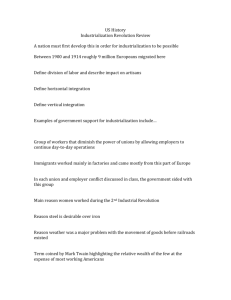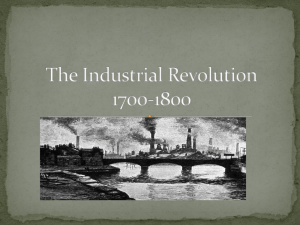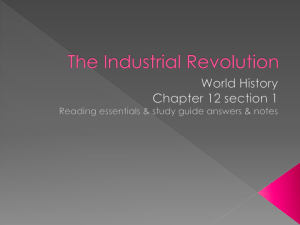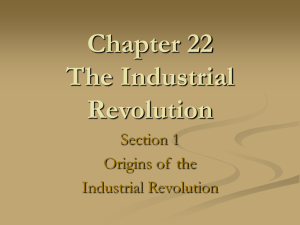The Industrial Revolution
advertisement
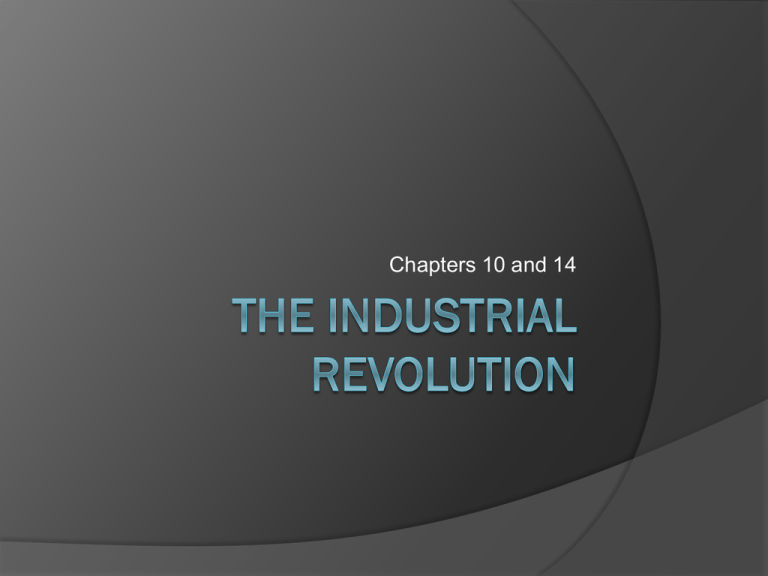
Chapters 10 and 14 Basic Information Began in England in mid-1700’s Spreads to other parts of Europe and eventually to the United States by the end of the 1800’s. Occurs in two major phases First Industrial Revolution: advances in agriculture, mechanization of textile industry, steam power, etc. Second Industrial Revolution: advances in steel, chemicals, electricity, etc. Why England??? Political stability following Glorious Revolution A tolerant society that allowed all groups to participate in the economy Population Growth =labor force and consumers Agricultural Revolution (cont. on next slide) Thriving cottage industry (domestic system) Enclosure Movement= individual initiative and increased productivity Strong economy due to banking and credit institutions A growing middle class that could invest in industry Thriving overseas trade Expertise with shipping and merchant activity Availability of natural resources (coal and iron) Agricultural Revolution Advances in agricultural technology helped to provide a growing population as well as new technologies that would increase productivity Crop Rotation increased yields Growth of different food crops New machines to improve efficiency Higher population= larger work force Mechanization of farm equipment cut back on the need for labor, which forced people to move to the cities in search of work Textiles: the first major industry Cottage Industries (domestic system) used for centuries 1700’s: new inventions to increase productivity of textile industry John Kay- flying shuttle James Hargreaves- spinning jenny Richard Arkwright- water frame Textile manufacturing began to move out of the homes and into factories Textiles: the first major industry Increased demand for cotton British interest in India grew ○ India was the world’s leading producer of cotton in the early 1700’s “King Cotton” in the American South ○ Slavery expanded rapidly as southern states attempted to meet the growing demand for cotton Steam: a new source of power Originally, factories had to be located near a river for power James Watt invented a steam engine Iron Production Originally, the process of smelting iron required hot ovens fueled by charcoal, but deforestation in England led to a shortage of charcoal Abraham Darby discovered a process for using coal to smelt iron, which led to increased iron production RailRoads Increased iron production combined with the steam engine led to a boom in the railroad industry 1830, the first passenger railroad was opened in England Railroads helped to create a boom in the economy Created jobs, sped up transportation A Second Industrial Revolution The late-1800’s ushered in advances in steel, electricity, transportation and communication Often known as the Second Industrial Revolution Steel In the late-1800’s, steel became the metal of choice for construction of buildings and ships Stronger and more durable than iron 1856: Henry Bessemer developed the Bessemer Process for the manufacture of steel William Siemens further improved the process for manufacturing high-quality steel Electricity 1879: Thomas Edison invented the incandescent lamp (light bulb) 1881: the first electric power station was built in Great Britain Electricity transformed the lives of people Factories had more power and could run after dark Nighttime activities became increasingly available Communication 1830: Telegraph invented by Samuel Morse 1876: Telephone invented by Alexander Graham Bell Motion pictures began to be created in the 1890’s Transportation By the end of the 1800’s, Europe had laid over 100,000 miles of RR track Steamships and steam locomotives Refrigerated cars aid in shipping of perishable goods 1885: internal combustion engine 1903: Orville and Wilbur Wright launched a successful flight in Kitty Hawk, North Carolina Spread of Industrialization Belgium began to industrialize It too had plentiful coal and iron deposits German states quickly industrialized France lagged behind due to political instability leading up to and during the French Revolution Spain was slower to industrialize due to less advanced transportation systems Russia also slow to industrialize due to lack of a significant middle class and underdeveloped transportation systems Impact of Industrialization Western Europe became extremely powerful in the world, began to dominate for the first time in world history Urbanization Poor conditions in cities Family life changed as most members of the family went outside of the home to work (including women and children) Child labor Demand for government reform to aid workers and improve conditions Harm to the environment Deforestation, pollution, depletion of natural resources (coal and iron deposits)

